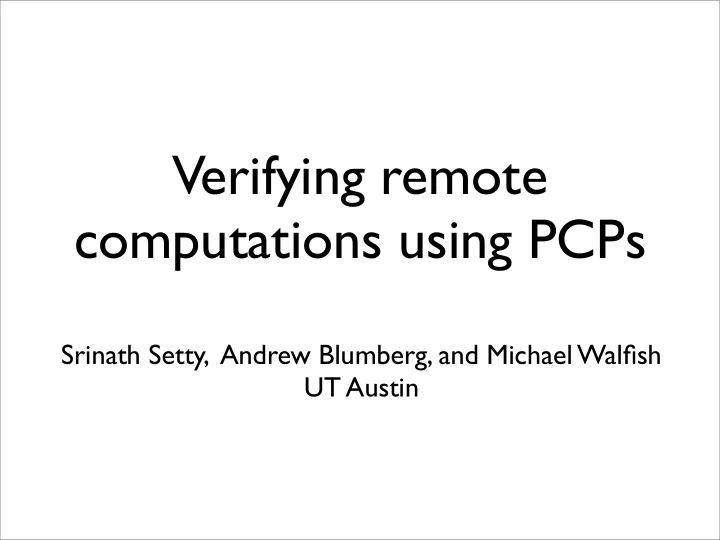

Verifying remote computations using PCPs Srinath Setty, Andrew Blumberg, and Michael Walfish UT Austin
Can we build this? Computation F(x) Server Client y output
Can we build this? Computation F(x) Server Client y output • Check if y equals F(x) without re-executing
Can we build this? Computation F(x) Server Client y output • Check if y equals F(x) without re-executing • Unconditional: no assumptions
Why should we build this? • Offloading computations to the cloud • Outsourcing computations to volunteer machines (Enigma@home, Einstein@home, ...)
How can we solve this problem in principle? • Probabilistically checkable proofs (PCPs) and argument systems [Arora et al. JACM, 1998]
How can we solve this problem in principle? • Probabilistically checkable proofs (PCPs) and argument systems [Arora et al. JACM, 1998] • PCP theorem: server proves that y = F(x) and client validates without re-executing
We have a conflict • PCPs are mind-blowing
We have a conflict • PCPs are mind-blowing • But the costs are also mind-blowing
We have a conflict • PCPs are mind-blowing • But the costs are also mind-blowing ‣ For polynomial evaluation (700 variables), the server takes 10 5 years!
We have a conflict • PCPs are mind-blowing • But the costs are also mind-blowing ‣ For polynomial evaluation (700 variables), the server takes 10 5 years! • Our research program: try to make PCPs practical
Rest of this talk: • Overview of PCPs • Our refinements
PCPs from 200,000 feet F(x) Client Server y F(x) Boolean circuit
PCPs from 200,000 feet F(x) Client Server y F(x) Boolean circuit Proof
PCPs from 200,000 feet F(x) Client Server y F(x) Proof Boolean circuit Proof
PCPs from 200,000 feet F(x) Client Server y Random F(x) locations Proof Boolean circuit Proof
PCPs from 200,000 feet F(x) Client Server y Random F(x) locations Proof Proof Boolean circuit Chosen values Proof
PCPs from 200,000 feet F(x) Client Server y Random F(x) locations Proof Proof Boolean circuit Chosen values Accept/ Tests Proof Reject
Our attempt to make PCPs practical • Build on the work that introduces interaction [Kilian CRYPTO’95, Ishai et al. CC’07] • Use a higher-level abstraction to represent computations ‣ Reduces cost by 8 orders of magnitude • Apply a divide-and-conquer technique ‣ Reduces cost by 2 orders of magnitude
We build on an interactive variant of PCPs [Ishai et al. CC’07] • The server proof is a generating function • The server responds to queries by evaluating the function • The client binds the server to its function using cryptographic commitment
Can we use a higher- level abstraction? • Use arithmetic circuits instead of Boolean circuits • Savings: ‣ 8 orders of magnitude at the server ‣ 4 orders of magnitude at the client
Can we apply a divide- and-conquer strategy? • Decompose the computation into parallel pieces • The client batch-verifies the computation • Saves two orders of magnitude in costs
Examples that we implemented • Polynomial evaluation • Matrix multiplication • Fast Fourier Transform (FFT) • Image filtering with convolution matrices
Example savings For polynomial evaluation with 700 variables interactive post- baseline refinements Server’s work 130,000 years 11.5 hours Client’s work 940 sec 94 msec (Local execution time: 164 msec) The scheme is near-practical
Summary • Our refinements reduce costs by over 10 orders of magnitude • More refinements are required to make the scheme fully practical • Upshot: PCP-based verified computation can be a systems problem
Recommend
More recommend